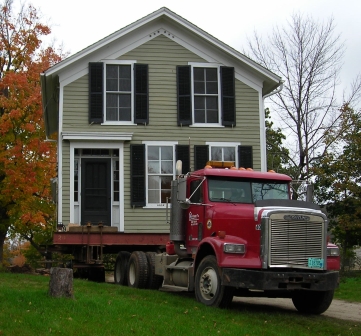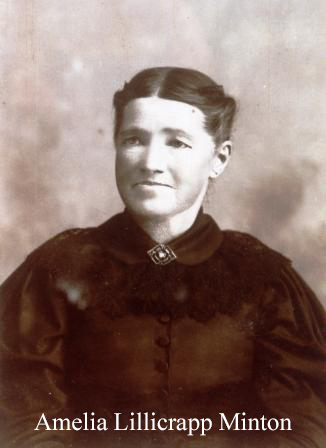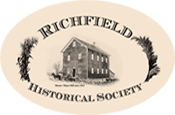History of the Lillicrapp Welcome Center
The Lillicrapp home is an adaptation of classic Greek architecture in vogue in America from 1820-1860 and was moved to the Richfield Historical Park by the Historical Society from Amy Belle Lake where it was built around 1860. In its lifetime, it has had numerous owners from those engaged in farming, carpentry, apple growing, medicine and religion.
to the Richfield Historical Park by the Historical Society from Amy Belle Lake where it was built around 1860. In its lifetime, it has had numerous owners from those engaged in farming, carpentry, apple growing, medicine and religion.
RICHARD LILLICRAPP ERA; 1844 – 1876
On August 1, 1846 a land patent (original certificate of purchase) under the signature of James K. Polk, President of the United States was issued to Richard Lillicrapp for a 40 acre parcel which was mostly lake. The property was located in the SW ¼ of the NE ¼ of Section 25 in the Town of Richfield. The cost of the 40 acres was $50.00 or $1.25 per acre. The 40 acres was mostly water, a lake that became known as Lillicrapp Lake and later Amy Belle Lake.
The 1850 census lists Richard Lillicrapp and wife Mary Pearse Lillicrapp  and their 6 children (James, Robert, Edward, Elizabeth, Amelia and Adolphus) as living on the property. Richard Lillicrapp was a farmer 52 years of age with real estate valued at $2,000.00 at the time he immigrated to America with his family, reportedly from Stockwell, England. An abstract indicates the family of eight lived on this 40 acres for 11 or 12 years. It is presumed their home during these years was a log structure like that of many early pioneers.
and their 6 children (James, Robert, Edward, Elizabeth, Amelia and Adolphus) as living on the property. Richard Lillicrapp was a farmer 52 years of age with real estate valued at $2,000.00 at the time he immigrated to America with his family, reportedly from Stockwell, England. An abstract indicates the family of eight lived on this 40 acres for 11 or 12 years. It is presumed their home during these years was a log structure like that of many early pioneers.
On November 29, 1856 Richard Lillicrapp added 160 more acres to his holding, an 80 acre parcel to the south and another 80 acres attached to the east of his original 40 acres. Both parcels were purchased from Harvey and Matilda Birchard for $100.00. From this time forward, the lake was known as “Lillicrapp” lake.
The 1873-1874 Township map shows two dots are shown on the original 40 acres side by side. This is the earliest confirmation of the existence of the frame farmhouse erected east of the original log cabin.
ADOLPHUS LILLICRAPP ERA – 1873 - 1886
Adolphus, the Lillicrapp son, and wife Adelia were successors to the Lillicrapp property. Richard died January 1, 1876. Mother Mary died in the spring of 1884 and presumably lived out her days in the old log cabin west of the frame farmhouse. Adolphus is listed as a farmer in the 1870 and 1880 census. After his move from the property in 1886, he became a practicing veterinarian and is known to have practiced in Waukesha as reported in his 1908 obituary.
The 1880 census shows Adolphus and first wife, Adelia, as having four  children: Maud (age 8), Theophilus (age 7), William (age 5), and Mary (age 3). Later documentation shows both boys, Theophilus and William dying within a month of each other the following year, 1881. Daughter, Maud, married George E. Gerken of Waukesha and daughter, Mary, married C. A. Biebler of Chicago. Ida Wilhelm became the second wife of Adolphus after the death of Adelia in 1887. Photo: (Back Left to Right) ?, Mary Lillicrapp Biebler, (Middle Left to Right) Maude Lillicrapp Gerken, Ida Wilhelm Lillicrapp, Biebler Grandchildren.
children: Maud (age 8), Theophilus (age 7), William (age 5), and Mary (age 3). Later documentation shows both boys, Theophilus and William dying within a month of each other the following year, 1881. Daughter, Maud, married George E. Gerken of Waukesha and daughter, Mary, married C. A. Biebler of Chicago. Ida Wilhelm became the second wife of Adolphus after the death of Adelia in 1887. Photo: (Back Left to Right) ?, Mary Lillicrapp Biebler, (Middle Left to Right) Maude Lillicrapp Gerken, Ida Wilhelm Lillicrapp, Biebler Grandchildren.
The graves of Richard (1798 – 1876) and Mary (1799 – 1884) Lillicrapp and Adolphus (1837 – 1908) and wife Adelia (1844 – 1887) as well as several children that died at a young age are located at Union Cemetery south of County Hwy Q on Town Line Road – an extension of Amy Belle Road to the south never completed and known as “misery hill” due to its steep terrain.
HADFIELD ERA; 1886 – 1893
An Abstract of Title dated December 23, 1886 indicates that Adolphus and Adelia sold the entire 200 acre Lillicrapp property for $11,000 to the Hadfield family of Waukesha and Milwaukee. Immediately following the purchase, the Hadfield Company was formed as a partnership between Joseph and Abram Hadfield of Waukesha and George Hadfield of Milwaukee.
The business purpose of the Hadfield Company was “the quarrying, manufacture, buying and selling and dealing in stone as well as the manufacture of lime, building materials and the buying, selling and exchange of real estate, coal fuel and general merchandise.”
The Hadfield brothers, Joseph and Abram, built summer cottages directly across Amy Belle Lake from the Lillicrapp property in the spring of 1887 at which time A. H. Hadfield platted property around the shores of the lake and named the area “Beechwood” (The 40 acres east of the lake had many beechwood trees which could be used in their Waukesha lime kilns) He renamed the lake “Amy Belle” after his eldest daughter who had died at a young age. The Lillicrapp frame farmhouse is not known to have been occupied by any of the Hadfields. By 1891, the Hadfield Company had become insolvent; and on March 1 1893, the property was sold with the exception of lots 4 - 7 of the “Beechwood Addition ”to Frederich Kufahl.
KUFAHL ERA; 1893 – 1939
Frederich Kufahl as remembered by his grandchildren, Roger Stahnke and Dorothy Stahnke Braeger, had a long grey beard and was very hard of hearing. He had fought in the Civil War in the 9th Regiment Company G, had been mustered in in Milwaukee 11/10/1861, been held a prisoner at Newtonia and mustered out 12/3/1864. Frederich owned the 200 acre property from 1885 – 1908. He farmed the property and planted the whole south side of the lake in an apple orchard. It is known that William Kufahl (son) owned the property from 1908 – 1914. Frederich Kufahl gave his daughter Grace the lot with the log cabin on it. Grace Kufahl was the mother of Roger Stahnke and Dorothy Stahnke Braeger. Their father was Emil Stahnke. (Although unconfirmed at this time, it is possible Grace Kufahl Stahnke was the daughter of Edward Lillicrapp.) Frederick Kufahl is known to have had another son, John, and daughter, Josephine Kufahl Pickhardt.
SARGEANT ERA; 1939 - 1974
Dr. and Mrs. Harry (Katherine) Sargeant purchased the property with the frame farmhouse from Josephine Pickhardt, daughter of Frederick Kufahl in 1939. The Sargeants had two children (Helen Sargeant Zentner and Tom). Dr. Sargeant was a physician on the staff at Froederdt Hospital in Milwaukee.
In the 1940s, the Sargeants engaged architect Louise Gottschalk and landscape architect Walter Holzbog to renovate the property. At that time a large living room was created out of a parlor and dining room. The separating partition was taken out, a window removed and fireplace added. New coving was installed which had been taken from an old house being torn down. The former pantry became the kitchen and the original four upstairs bedrooms reached by entry stairs with a black walnut banister became two bedrooms and a bath. In 1958, a screened porch facing the lake was added, and the south side of the house became a bathroom and utility room.
KINDEM ERA; 1974 – 2007
Ingolf (“Hitch”) Kindem, a Milwaukee Lutheran minister, and wife Betty Kindem purchased the frame farmhouse at 751 Amy Belle Lake Road in 1974. They purchased the property from Katie Sargeant, widow of Dr. Harry Sargeant. The Kindem’s four children (Paul, Hap, Christopher and Heather) were already grown when they moved into 751 Amy Belle Lake Road. However, during the 33 years of the Kindem Era, their children and seven grandchildren (Peter, Tommy, Paul, Mark, Tim and Sam and Laura Bachus) spent many happy hours at Amy Belle Lake.
In the words of Betty Kindem: “We can care for the land, even pay taxes, but in the final analysis we are only privileged caretakers, privileged to be close to the earth, the sky and the water.” Much of the Kindem philosophy was expressed, according to “Hitch” Kindem, in 1794 by Tecumseh, the articulate Shawnee Native American leader, who said: “land could no more be sold in parcels than the air, the clouds and the great sea.”
KORONA ERA; 2007
Betty Kindem, widow of Ingolf Kindem, sold the frame farmhouse with its remaining orchard trees to neighbor Carolyn Korona in the spring of 2007. A new house was planned for the property, and the historic frame  farmhouse was offered to the Richfield Historical Society. It was moved to the north end of the Richfield Historical Park where has been preserved for many generations to come. The house is now the Lillicrapp Welcome Center with an interesting general store display and the Richfield History Room.
farmhouse was offered to the Richfield Historical Society. It was moved to the north end of the Richfield Historical Park where has been preserved for many generations to come. The house is now the Lillicrapp Welcome Center with an interesting general store display and the Richfield History Room.
If you enjoyed this month's story
Come back next month for another story

